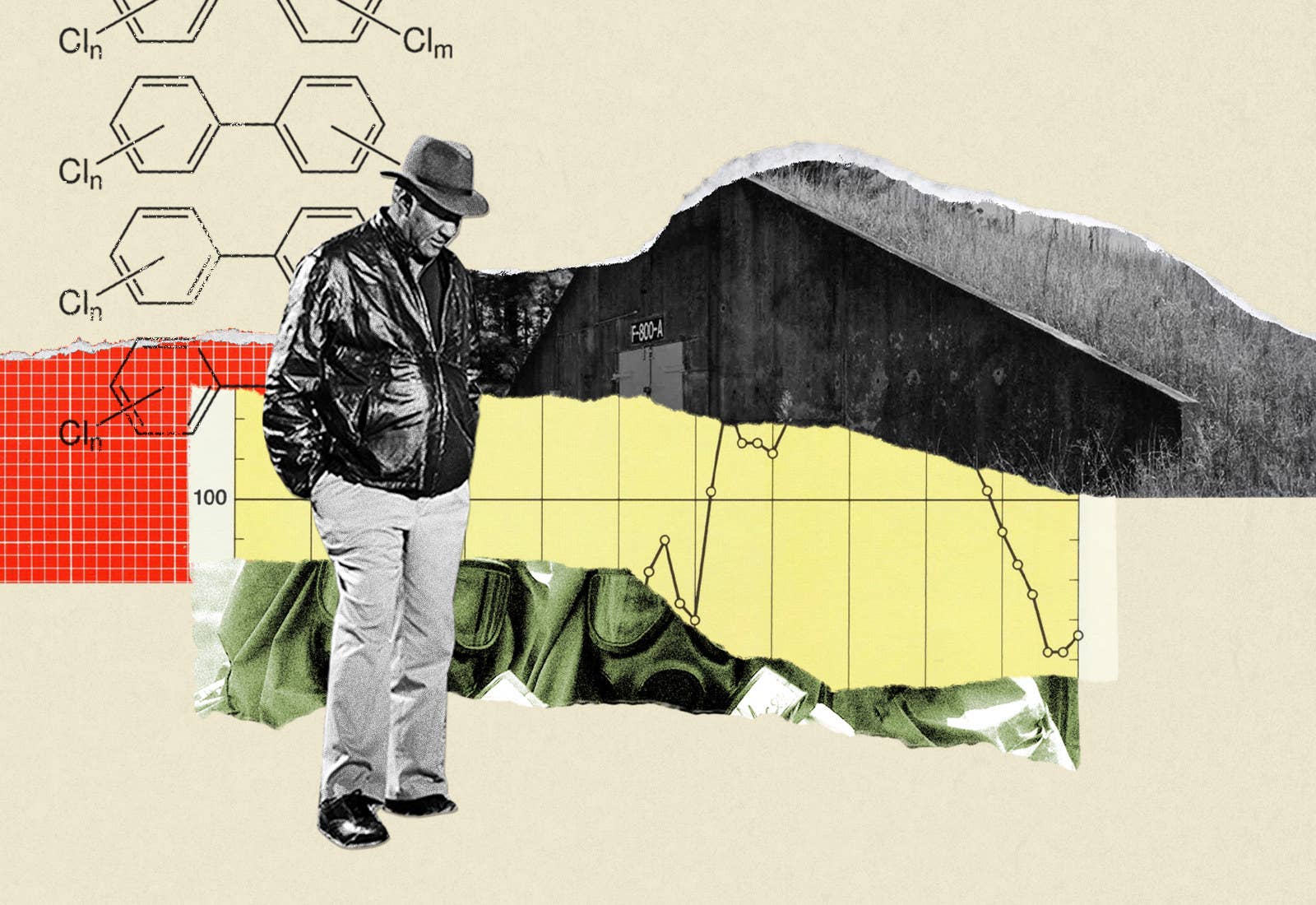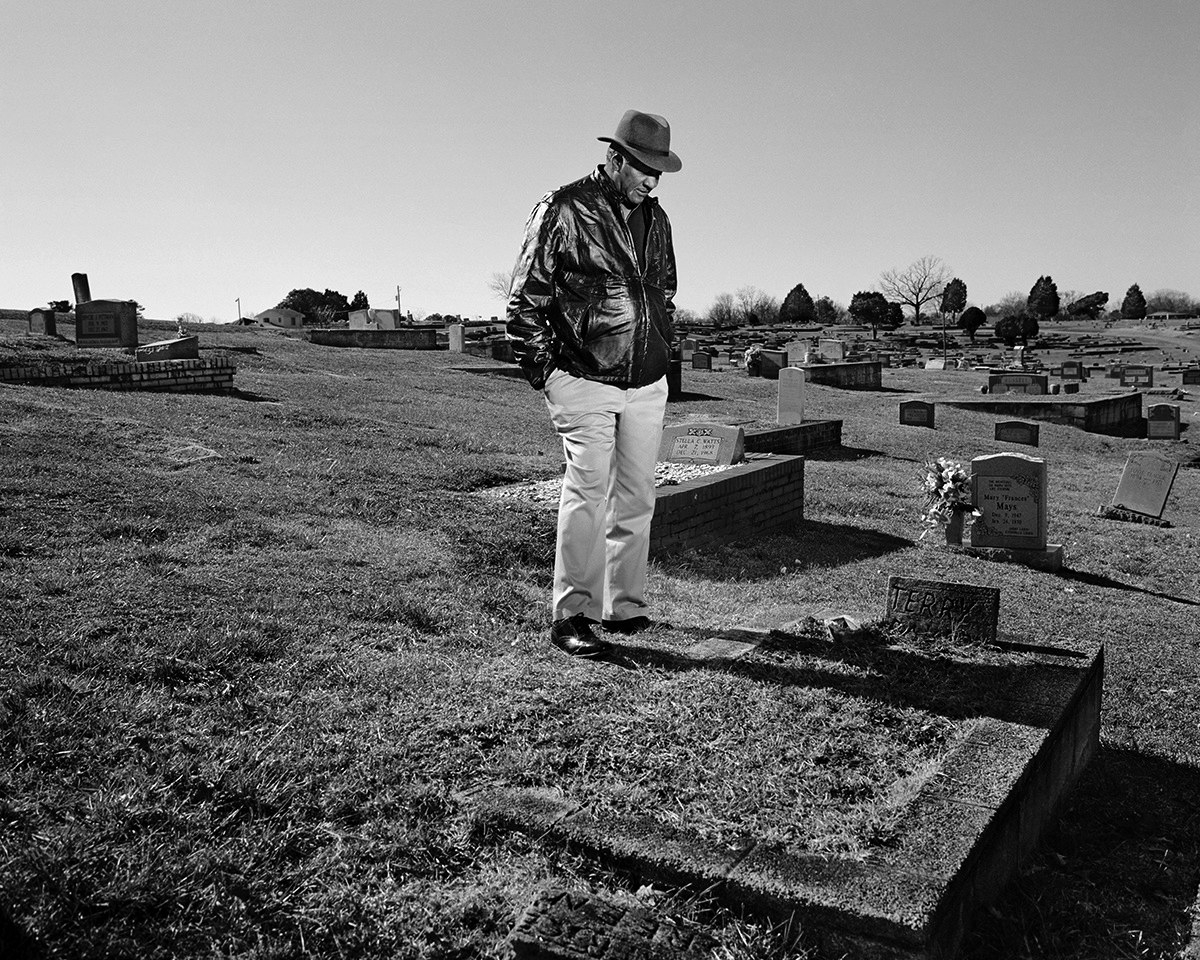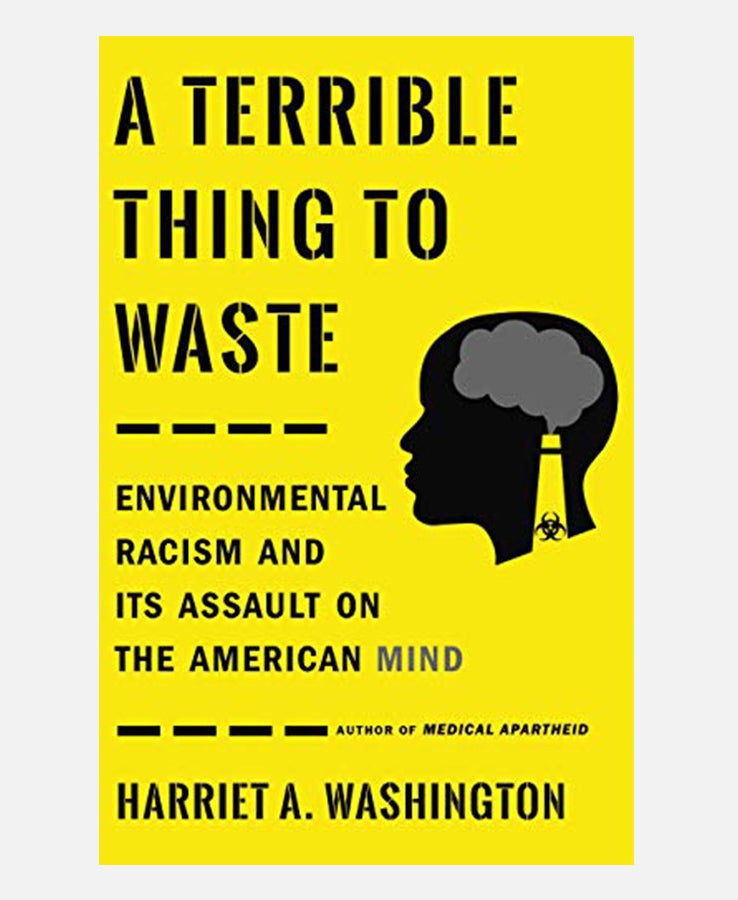
Shirley Baker, a nurse, deftly ties on a surgical mask before opening the door. But she’s not striding into the operating room: she is about to mow her lawn, which is ringed by a high chain-link fence festooned with biohazard signs. Baker lives in Anniston, Alabama, 63 miles from Birmingham. Her city of 24,000 is 52 percent African American, but mostly it’s the city’s black residents who inhabit the neighborhoods that have fallen into decay wrought by widespread pollution. These form a patchwork quilt of moribund communities and biological “dead zones” where nothing grows. Behind some doors, the unemployed fight cancer, paralysis, memory loss, and a bewildering array of poorly characterized diseases. Subdued children play, eerily quiet, against a backdrop of toxic lawns, oily creeks, tainted vegetation, and sere trees. Other neighborhoods are already dead. Vegetation has overtaken blocks of abandoned houses, with streetlights gone permanently dark, empty churches, and, always, the biohazard signs. Everywhere in Anniston, worried parents shoo children from parks and playgrounds. Many backyard creeks run blood red. Homeowners have forsaken their poisoned gardens to grow greens in sterile plastic buckets.
Children here seem slower and sicker than most, says Shirley’s husband, David, whose own brother died at 16 after years of illness. His daughter displays an assortment of behavior problems and has been relegated to special-education classes. A ten-year-old girl down the street has uterine cancer, he says, and he repeatedly assured me that several children nearby have been born with “two brains.” I wonder whether he means that they were born without a normally developed corpus callosum, which separates the brain’s hemispheres, but I can’t find out: their parents don’t return my phone calls.
For many Americans, a modern dread of contamination has been distilled into cathartic post apocalyptic film fare such as 28 Days Later, Right at Your Door, or Dawn of the Dead that feature poisoned lands and communities thronged with those so degraded by infection and environmental exposures that they have lost their intelligence and even their humanity. Confronting these cinematic horrors allows us to share a benign frisson of fear, secure in the knowledge that when the lights come up, we’ll emerge into normalcy. But for Anniston, the apocalypse is all too real — and for most, inescapable.
His daughter displays an assortment of behavior problems and has been relegated to special-education classes. A ten-year-old girl down the street has uterine cancer.
Once, from 1929 to 1971, Anniston was a company town. First, the Swann Chemical Company produced polychlorinated biphenyls (PCBs) there. Then Monsanto Industrial Chemicals took over the plant in 1935. The $20 billion corporation Monsanto, which brought the world the sweeteners saccharin and aspartame, boasts versatile chemical production, a checkered past, and a highly controversial present. Monsanto has produced synthetic fibers, plastics including polystyrenes, pesticides, and agrichemical products. It has also acquired many chemical and electronics companies that make products as varied as aspirin and light-emitting diodes (LEDs).
Just last year, it merged with the equally rich and powerful Bayer Corporation.
Monsanto first devised or marketed DDT, dioxin, 2,3,7,8- tetra-chlorodibenzodioxin (TCDD), 2,4-D, 2,4,5-T (Colorless, crystalline, tasteless, and almost odorless organochlorine compounds used as insecticides whose health and environmental impact was indicted by Rachel Carson’s book Silent Spring in 1962) and halogenated hydrocarbons that are carcinogenic even in small doses, and dioxins. In 1960 an “agricultural” division was established, which trafficked in the hazardous defoliant Agent Orange57 as well as the controversial recombinant bovine somatrophin, hormones used to increase the milk yield of cows.
By 1969, the plant was Anniston’s major employer, discharging 250 pounds of PCBs into Snow Creek, at the heart of the city’s black residential community, every day. PCBs are “brain thieves” that erode the structures and functioning of the brain and nervous system, and they are also endocrine disruptors that impede the healthy physical and mental development that is normally guided by hormones. Although the company and its apologists insisted that one can tolerate significant amounts without ill effects, this reassurance rang hollow in Anniston neighborhoods that found themselves suddenly battling a legion of ailments from cancers to memory loss, confusion, and a slew of other intellectual problems. Children’s behavioral problems snowballed in Anniston, along with rates of attention-deficit disorder and poor school performance. The news media often focus their outrage on cancer clusters and visibly crippling lung and mobility ailments caused by PCBs.

But PCBs’ most persistent legacy is the invisible harm they wreak on the brains of the young. Industry and some media accounts downplay small exposures as innocuous— claiming that “50 bathtubs’ full” of PCBs at low concentration is required to do harm— but this has not been proven. In reality, extremely small amounts of PCBs harm the developing nervous systems of fetuses and children. Even very low concentrations are harmful for immature brains during their critical windows of development. In 2000, researchers calculated that a PCB concentration of just 5 parts per billion in a pregnant mother’s blood can have adverse effects on a developing fetal brain, giving rise to attention and IQ deficits that appear permanent. Five parts per billion is equivalent to one drop in 118 bathtubs full of water.
David Baker, Shirley’s husband, is one of many who have borne witness to the painful toll of PCB poisoning. Growing up, he and his brother Terry would play in the neighboring woods and rivers, exploring, shooting arrows, and splashing in creeks that ran with water containing PCBs. But their bond was severed in 1970 when Terry sickened dramatically and died of a spectrum of diseases.
Denise Chandler, 46, has also had a front-row seat to death caused by reckless pollution. She, too, regularly played with her brother in one of the neighborhood’s chemical-imbued ditches. “We floated our little boats in it and waded in it, but we didn’t know it was loaded with PCBs,” she recalled. Decades later, when they were finally tested, they discovered that they both had high blood PCB levels. She suffers from sarcoidosis, an autoimmune disease characterized by widespread tissue inflammation. Her brother suffered myriad health problems before he died of kidney failure at age forty. But their problems are more than physical: two of Chandler’s three children were diagnosed with learning disorders. From 1935 until 1971, without warning its neighbors, Monsanto disposed of tens of thousands of pounds of PCBs by dumping them into creeks or burying them in and around Anniston. But industry wasn’t the only source of Anniston’s chemical exposures: in 1917, the military established Fort McClellan there, and the U.S. Army manufactured and trained heavily with them from World War I until its closure in 1999.
“We floated our little boats in it and waded in it, but we didn’t know it was loaded with PCBs.”
Despite being saturated with environmental poisons, Anniston became an icon of normalcy when it was named the “All American City” in 1978. The very next year, Snow Creek began to run red, heightening residents’ suspicions about the effects of chemical exposures in their communities. In 1996, one of the dumps started leaking. It was then that residents began learning the extent of their contamination. Years of unchecked chemical dumping had utterly poisoned the lands of Anniston’s black neighborhoods. A former union organizer, David Baker took action, channeling the pain of his brother’s loss into ensuring that the citizens of Anniston receive justice. He created Community Against Pollution in 1998 to force the chemical companies to clean up the contamination and compensate those harmed by it.
At his urging, the EPA tested Anniston’s soil and water as well as the blood of its residents. It was alarmed to find that the blood of Anniston’s townspeople had the highest recorded levels of PCBs in the nation. But their complaints drew a desultory response from the industry, so Baker organized residents, who filed a number of lawsuits against the unresponsive Army and against Monsanto. As the evidence of Anniston’s poisoning mounted, Monsanto shed its industrial-chemical fibers business into a separate company called Solutia. It also began trying to buy up heavily tainted properties, including a local church. This further fueled residents’ suspicions that despite its denials, the company had long known how dangerous its dumped chemicals were. They were right.

In 1966, Monsanto had hired the late Mississippi State University professor Denzel Ferguson to investigate the health effects of its PCB pollution in Anniston. When Ferguson’s team of biologists lowered bluegill fish into the city’s creek all twenty-five fish died within three and a half minutes. “It was like dunking the fish in battery acid,” one team member told the Washington Post. “I’ve never seen anything like it in my life,” said another. Yet Monsanto ignored the biologists’ urgings to warn residents and clean up the waters. Monsanto did respond with alacrity to concerns about the fiendish toxicity of PCBs voiced by Swedish scientists the very next year. A Monsanto official wrote Emmett Kelly, the company’s medical director, beseeching him, “Please let me know if there is anything I can do so that we may make sure our business is not affected by this evil publicity.” In 1979, Monsanto closed the Anniston chemical factory.
In 2002, the people of Anniston suddenly learned from a 60 Minutes investigation that theirs was one of the most toxic cities in the nation. PCBs are widely disseminated in industry products, so widely in fact, that the average American has PCB blood levels of 2 parts per billion (ppb). But the mostly black victims of Anniston suffered huge exposures. Howard Frumkin, M.D., told me, “Anniston has the highest levels of PCB exposure of any town in America, of any town that I’ve ever heard of.”
When Denzel Ferguson’s team of biologists lowered bluegill fish into the city’s creek all twenty-five fish died within three and a half minutes.
Most of the residents know their levels. As in most toxic communities, the PCBs in Anniston were not acting alone. Anniston is blanketed by a mixture of asbestos, arsenic, and other unstudied chemicals. Even if their effects had been known, mixtures of chemical exposures can act in an unexpected manner. One chemical might mute or potentiate the effects of others in an additive, or even a synergistic, manner. Lead, cadmium, arsenic, and mercury are pollutants that are commonly found together, and all have long-lasting effects on the brain.
According to a 2016 study published in Environmental Toxicology Pharmacology, the metals share many common pathways for causing cognitive dysfunction, and all bind to a particular receptor, which makes their effects synergistic: harmful exposure to the mixture results in a greater poisoning than the added effect of poisoning by each of its members. Anniston residents filed class-action suits against Monsanto Chemical, alleging that it had knowingly dumped PCBs into the local water supply for decades. Like the Anniston Army Depot, Redstone Arsenal, and other industries, Monsanto had also exposed residents to asbestos, which can cause diseases like the deadly lung cancer mesothelioma.
Residents settled a case against the company in April 2001 for $43 million, and in 2003, a jury determined that the Anniston Monsanto plant had imbued Anniston with PCBs. Monsanto and Solutia agreed to pay $600 million to settle the claims, but Solutia declared bankruptcy that very year. Its forty-year monopoly on PCBs left Monsanto with a long history of injury and abandonment that was revealed to the world when incriminating Monsanto documents were posted on the Chemical Industry Archive website as a result of the lawsuits.The documents indicate that Monsanto long knew of the severe damage it caused by dumping millions of pounds of PCBs into Anniston for four decades.
In 2003, the Department of Defense began destroying the chemical-weapon stockpile, including nerve gas, stored at the Anniston Army Depot. Most of the settlement funds went to lawyers and cleanup efforts, leaving the people of Anniston unemployed, impoverished, sick, mentally hobbled, and, in many cases, dying. They were unable to sell their homes and flee. The Army and EPA had failed to protect them and they were unsure where to turn next.
Adults received an average of $9,000 each, and each child $2,000, an absurdly low amount considering that each faces a lifetime of disability.
David Baker, now the executive director of Community, was sure of one thing: they needed a powerful champion. He found one: Johnnie Cochran. Baker approached Cochran, who was fresh from securing O. J. Simpson’s not-guilty verdict, and after hearing stories of Anniston’s poisoning and rampant illness, Cochran agreed to help them obtain compensation for their property losses and a health clinic to address their cancer, liver disease, and mental problems. As he denounced the failure of the government to protect Anniston residents, Cochran declared, “There is always some study, and they’ll study it to death, then thirty years later, you find out it’s bad for you.... We know it’s bad for us right now!” Cochran’s class-action suit procured the largest settlement ever won in the United States. The victims of Anniston won $300 million from Monsanto, its subsidiary Solutia, Pfizer, and other firms, none of whom admitted any wrongdoing. Fifty million dollars was reserved for a health clinic to address the medical aftermath of Anniston’s poisoning.
The celebration was short-lived. About 47 percent of the settlement— some $142 million— went to the 18,447 plaintiffs. Adults received an average of $9,000 each, and each child $2,000, an absurdly low amount considering that each faces a lifetime of disability, including reductions in IQ, that erode earning ability. With the exception of the portion of the settlement set aside to fund the health clinic, the rest of the money went to pay the lawyers. The townspeople’s expectation of life-altering financial compensation evaporated, and most remained trapped in their tainted homes. The health clinic ran out of funds and closed in 2017.
In comparison, victims of Japan’s Minamata poisoning, caused by the release of methylmercury from the Chisso Corporation’s chemical factory from 1932 to 1968, reaped $1 billion in compensation, an average of $20,000 per person. Today, Anniston’s community meetings are thronged with the sick, who tend to introduce themselves by ticking off their sky-high PCB levels and bestiary of diseases. Even the relatively young compare their cancers and frailties. Baker speaks of filing another lawsuit, but without his old fervor; he has received anonymous death threats from neighbors who felt betrayed by their low compensation from the earlier settlement. Even an outsider can see that their solidarity is diminished. “Monsanto did a job on this city,” summarizes Opal Scruggs, sixty-five, who, like everyone else in her neighborhood, has elevated blood levels of PCBs. “They thought we were stupid and illiterate people, so nobody would notice what happens to us.” ●
Adapted from A Terrible Thing to Waste: Environmental Racism and Its Assault on the American Mind. Copyright © 2019 by Harriet A. Washington. Used with permission of Little, Brown and Company, New York. All rights reserved.

Harriet A. Washington has been the Shearing Fellow at the University of Nevada's Black Mountain Institute, a Research Fellow in Medical Ethics at Harvard Medical School, a senior research scholar at the National Center for Bioethics at Tuskegee University, and a visiting scholar at DePaul University College of Law. She has held fellowships at the Harvard T.H. Chan School of Public Health and Stanford University. She is the author of Deadly Monopolies, Infectious Madness, and Medical Apartheid, which won a National Book Critics Circle Award, the PEN/Oakland Award, and the American Library Association Black Caucus Nonfiction Award.
